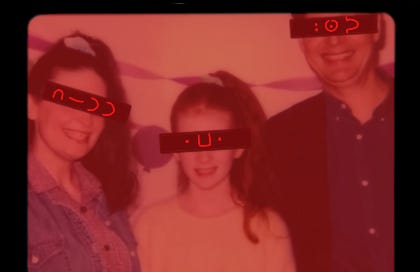The Downstairs Man: ‘Longlegs’ Review
Director Osgood Perkins delivers a chilling, slow-burning Occult thriller
I want to start off by saying that Neon deserves a round of applause for the marketing for this film.
The trailers, promos, and reviews for this film built up the hype any film wants. The first trailer I remember seeing was of a woman poring over a book called The Nine Circles of Hell. Cryptic symbols were superimposed over her study session, eventually revealing the film’s title as Longlegs.
Like every other horror movie, it was labeled as the “Best/Scariest/Most Thrilling/Insert Adjective Film of the Year.” I was concerned that the marketing would lead to a film that didn’t deliver on the expectations it set up for itself. Especially with how strange and cryptic some of the teasers and promotional images were. But did it live up to the hype?
Director Osgood Perkins (The Blackcoat’s Daughter, Gretel & Hansel) brings us an arthouse-adjacent thriller following the clairvoyant FBI Agent Lee Harker (Maikq Monroe), who is assigned to the long-standing cold case of the titular Longlegs (Nicolas Cage), a serial killer who, somehow, commits his crimes without being present. Aided by her superior, Agent Carter (Blair Underwood), the two get pulled further into the twisted mystery and a surprising link between Harker and Longlegs.
The movie people walk in to see might not be what they’re expecting. We’re used to seeing films with a lot of jump scares and buckets of fake blood. That’s not what Longlegs is.
The cinematography is often rigid and claustrophobic, pitting still characters against artistic backgrounds which only aid in either isolating or making the characters feel more tense. There are dimly lit offices and cabins, snow-covered homes, and drizzly neighborhoods. The only times the films diverts from this style are the occasional tracking shots and Harker’s red-tinted visions of eerie photographs and clips of snakes and blood. Throw in the eerie sound design, and the film creeps into Lynchian territory.
There are also jumps between standard screen ratio and 4:3, coinciding with the scene taking place in either the then-present 1990s or the 1970s. It was a neat touch that helped distinguish the time periods.
The story feels like an FBI crime report, divided into three parts and filmed in tight shots that bring out the panic. Our killer’s methods for choosing his victims were unique and tied into the Occult themes running throughout the film. It’s the sort of thing that true crime fans would go rabid over online. The psychic detective story, or a detective hunting a killer, isn’t a new story but Longlegs himself makes the film feel refreshing.
Nicolas Cage easily gives the best performance in the film. He plays into the demented killer trope but dials it up to a new level of weird. He wears makeup to look pale, fidgets, and is prone to fits of screaming and singing. He looks like a crazy, old hitchhiker walking along the road, oddly enthusiastic about people’s birthdays. When you get to the Occult stuff and the dollmaking, it doesn’t seem as weird anymore.
The other actors do a serviceable job. Monroe as Harker could’ve had a little more depth and less blank stares to her character, but her caginess and quiet make sense and work for the character. Alicia Witt as Ruth, Lee’s mother, and Kiernan Shipka as Carrie Anne each give their own chilling performance as wide-eyed oddballs hiding something darker, particularly Shipka, who gives her sole scene everything she has to weird us all out. I’d love to see any of these characters challenge Eraserhead’s Henry Spencer to a staring contest.
Longlegs isn’t going to be for everyone. However, for fans of slow-burning tension, secret codes, and a more cerebral kind of horror, be ready to squirm in your seat.



